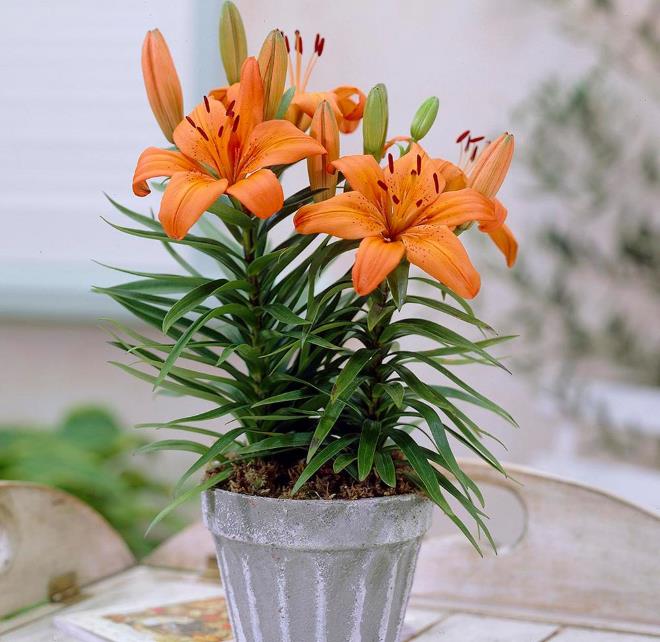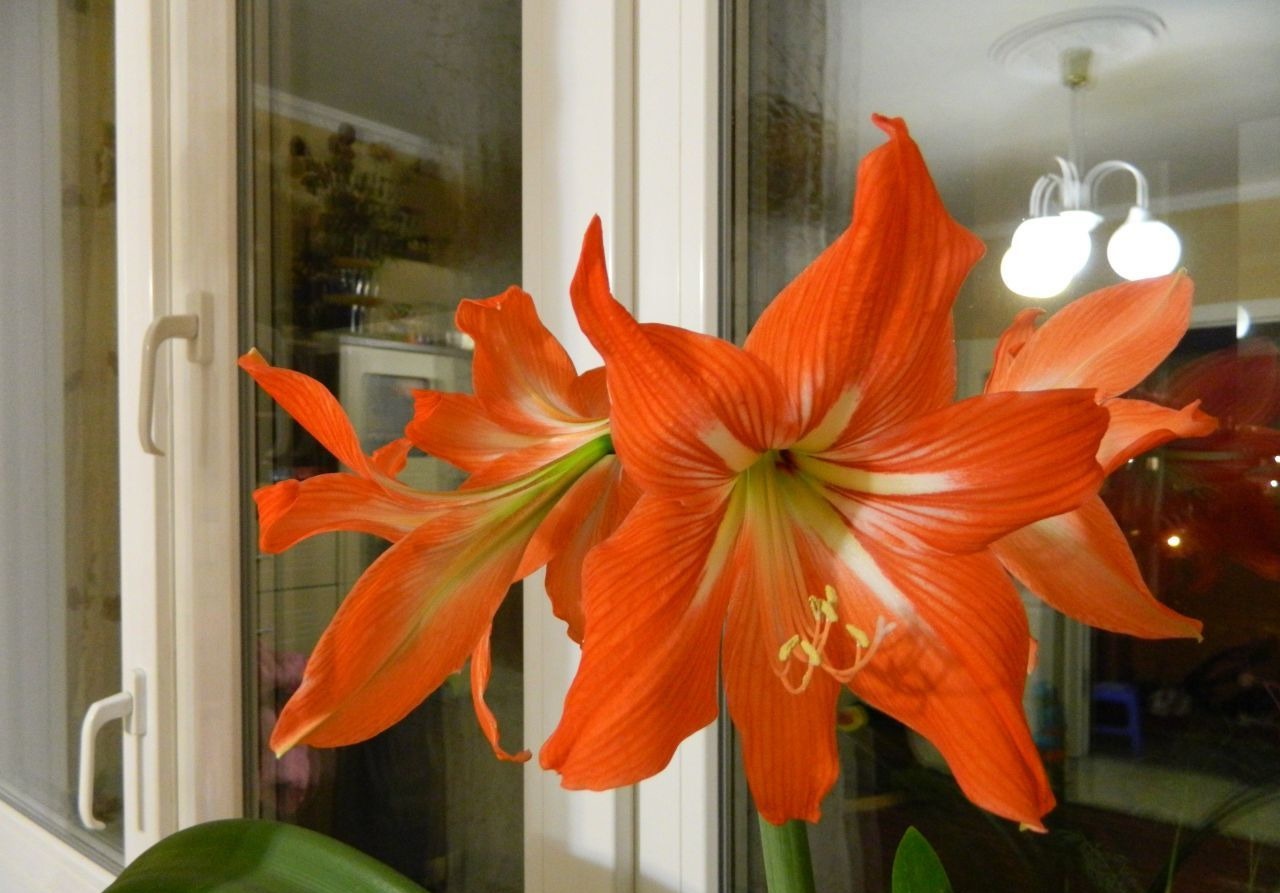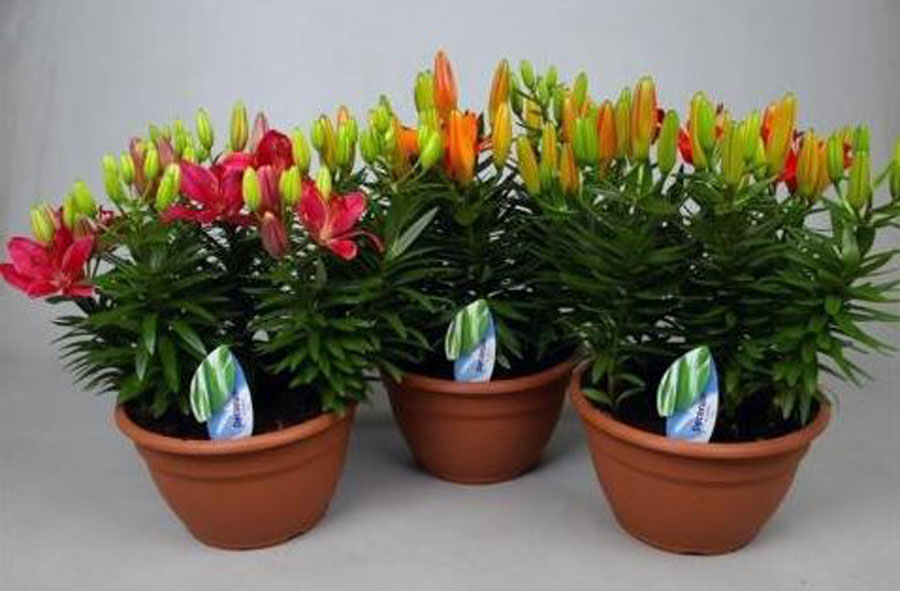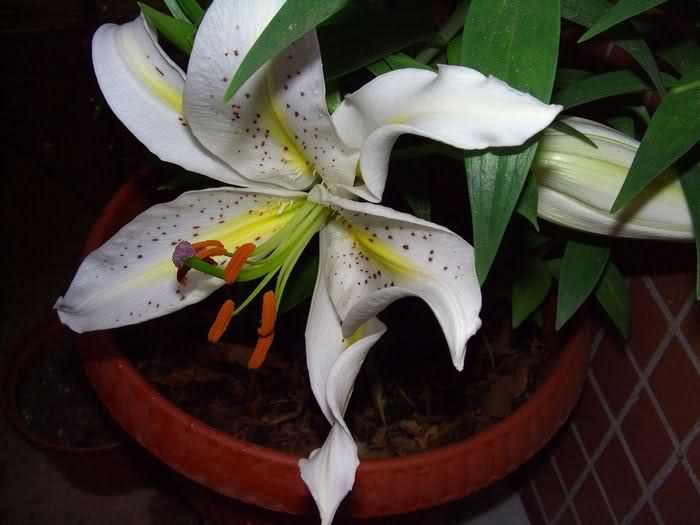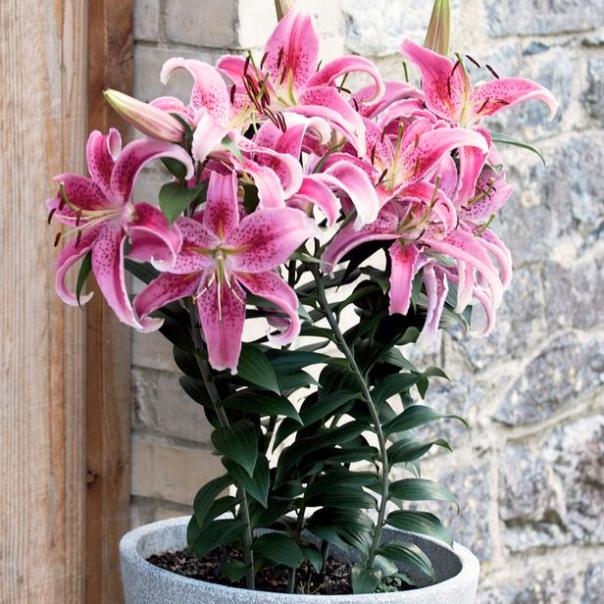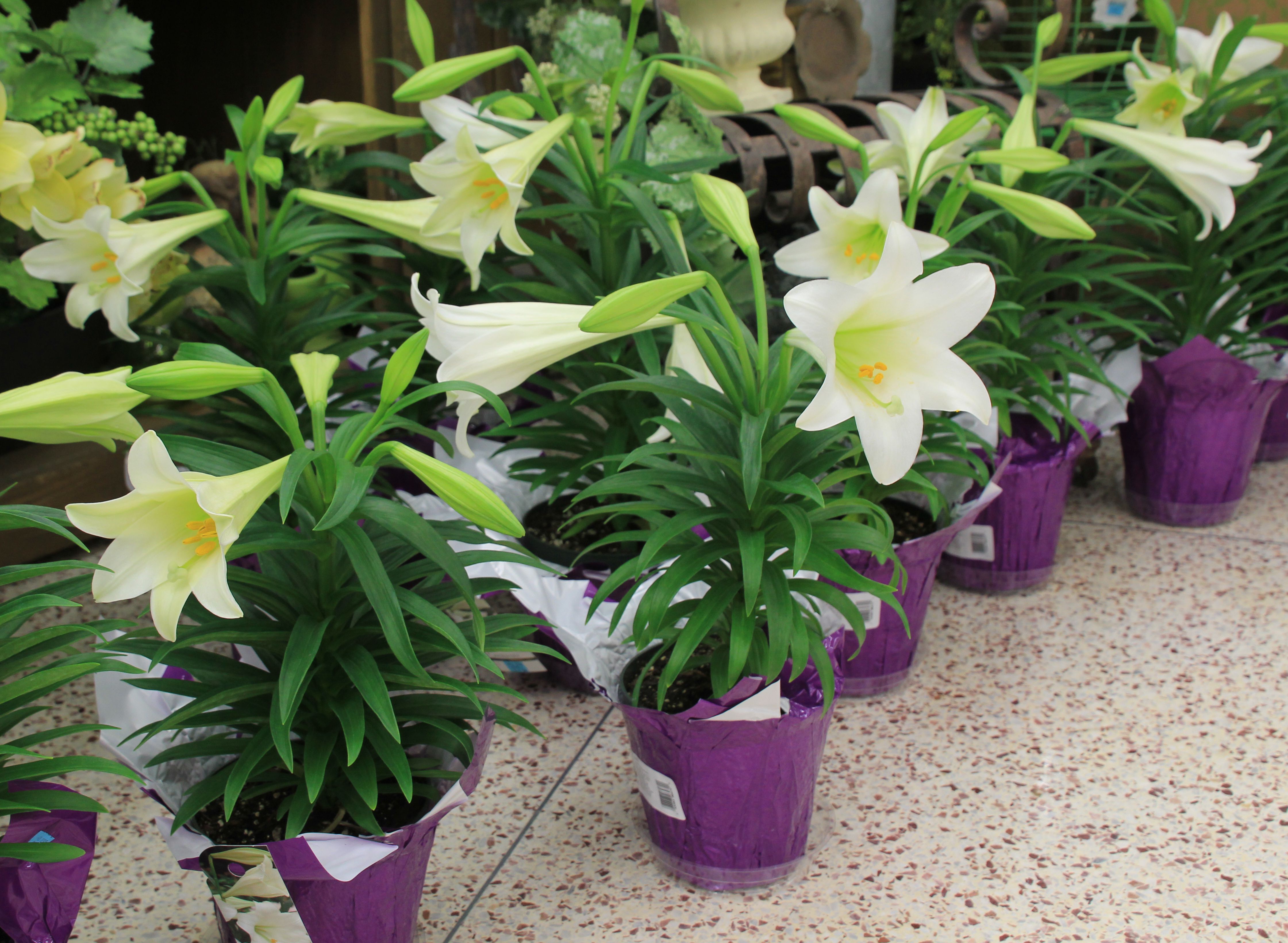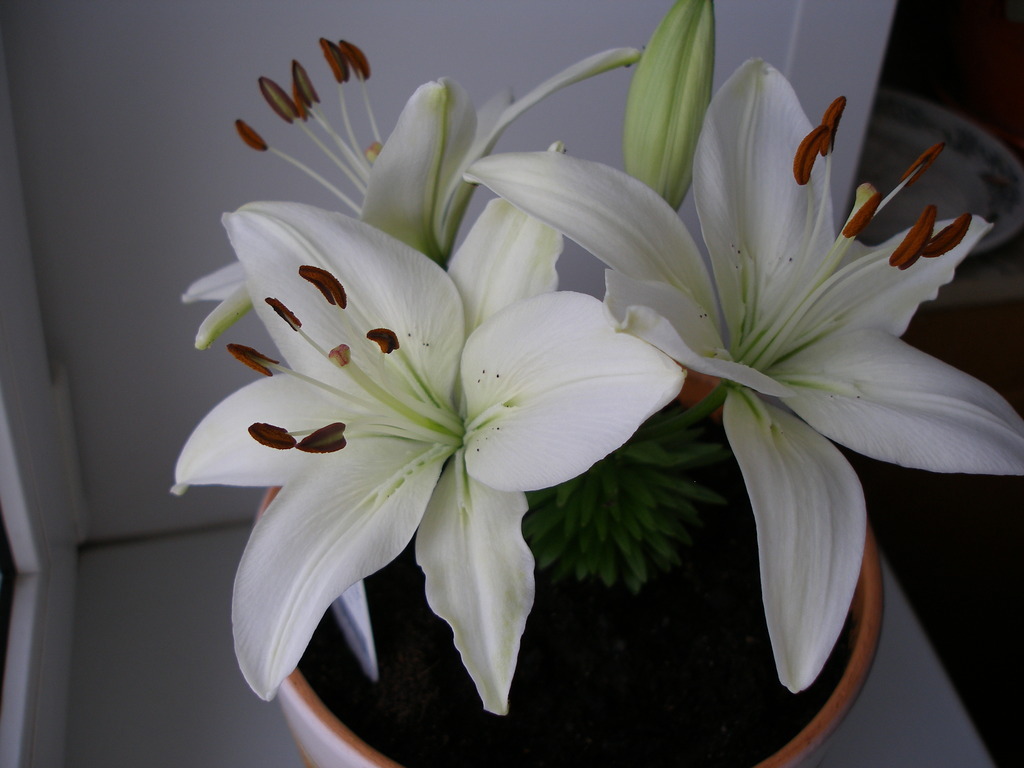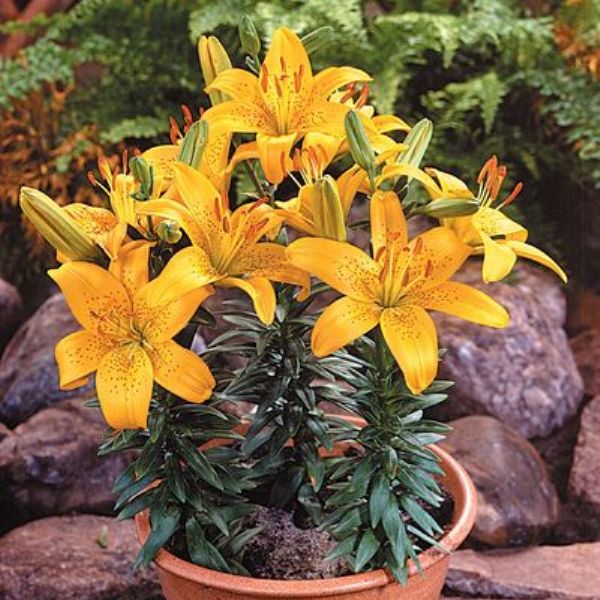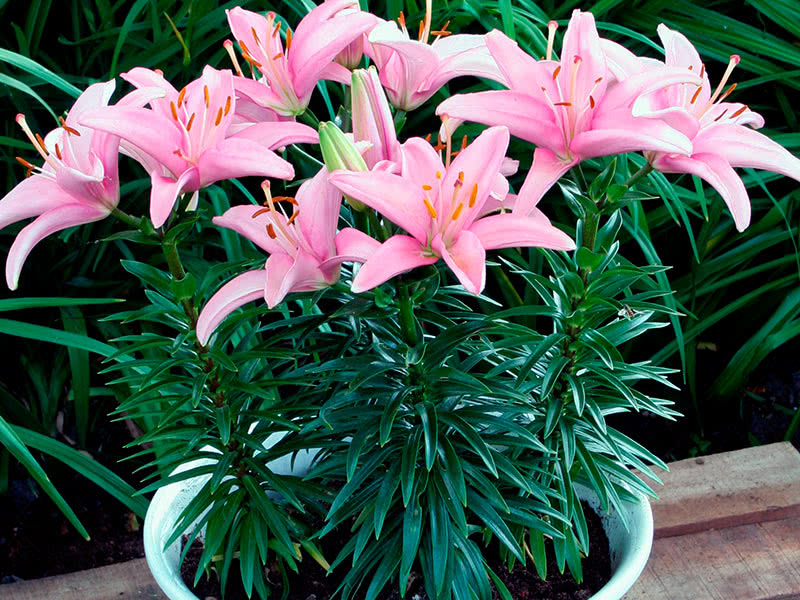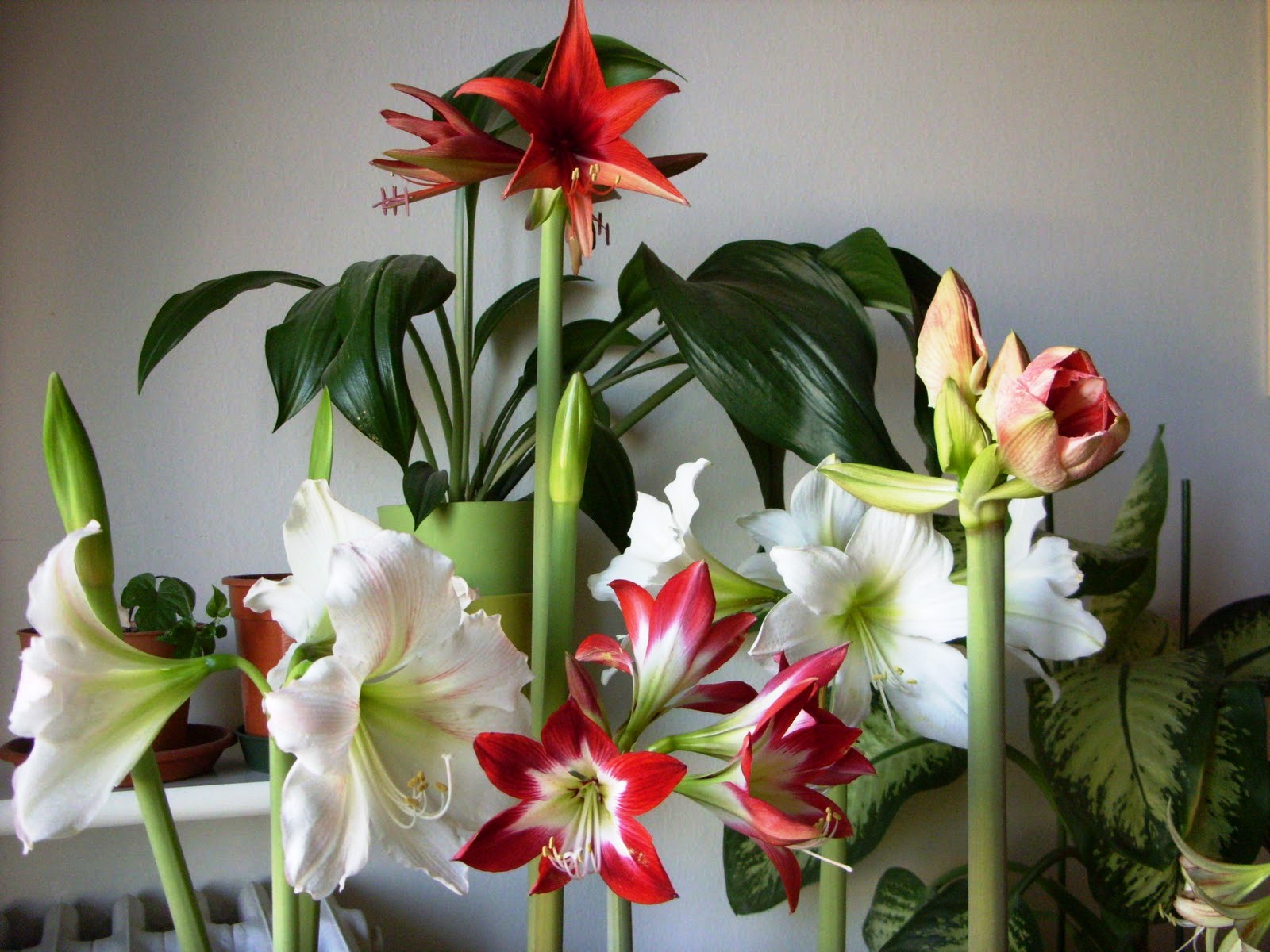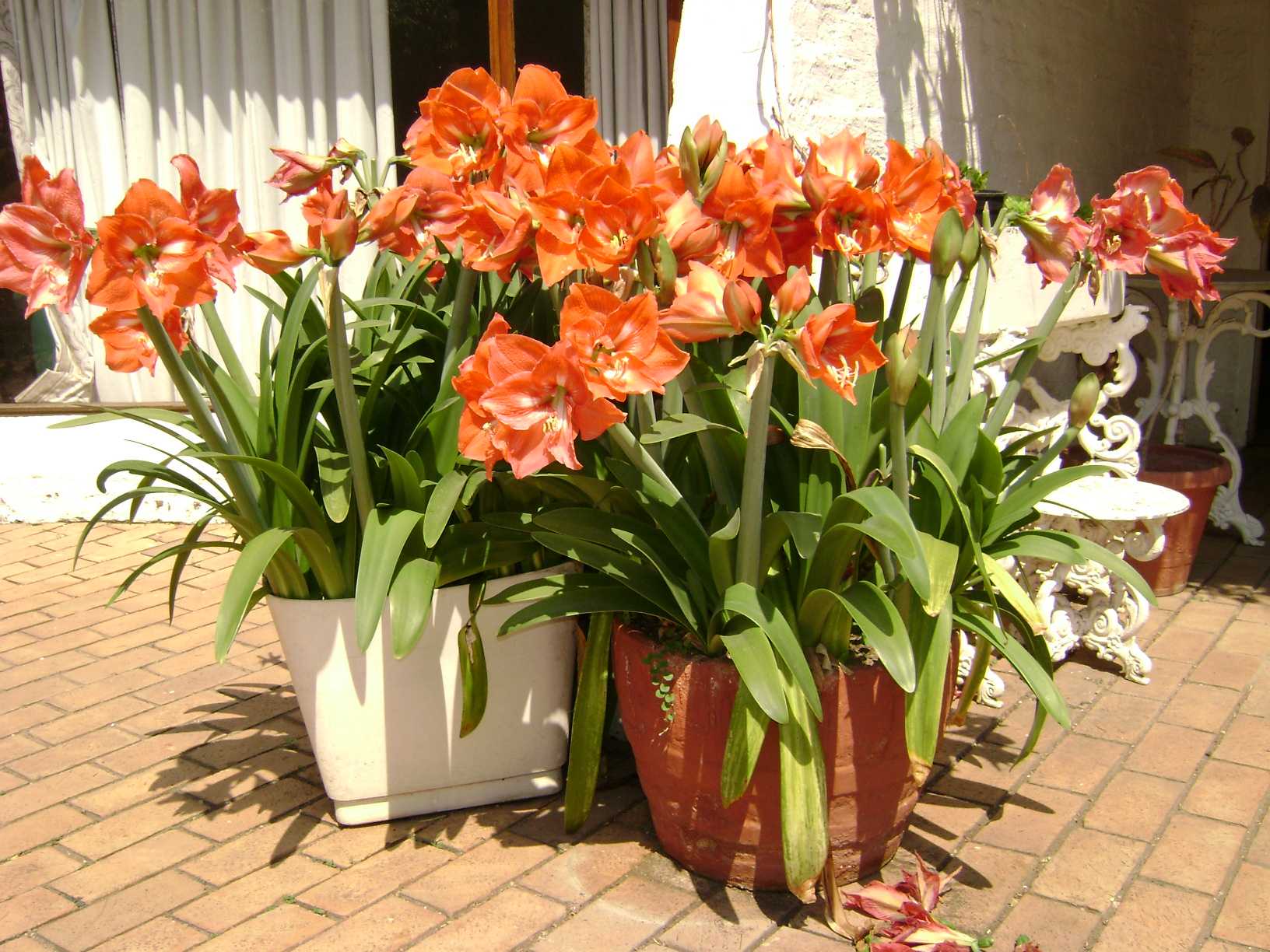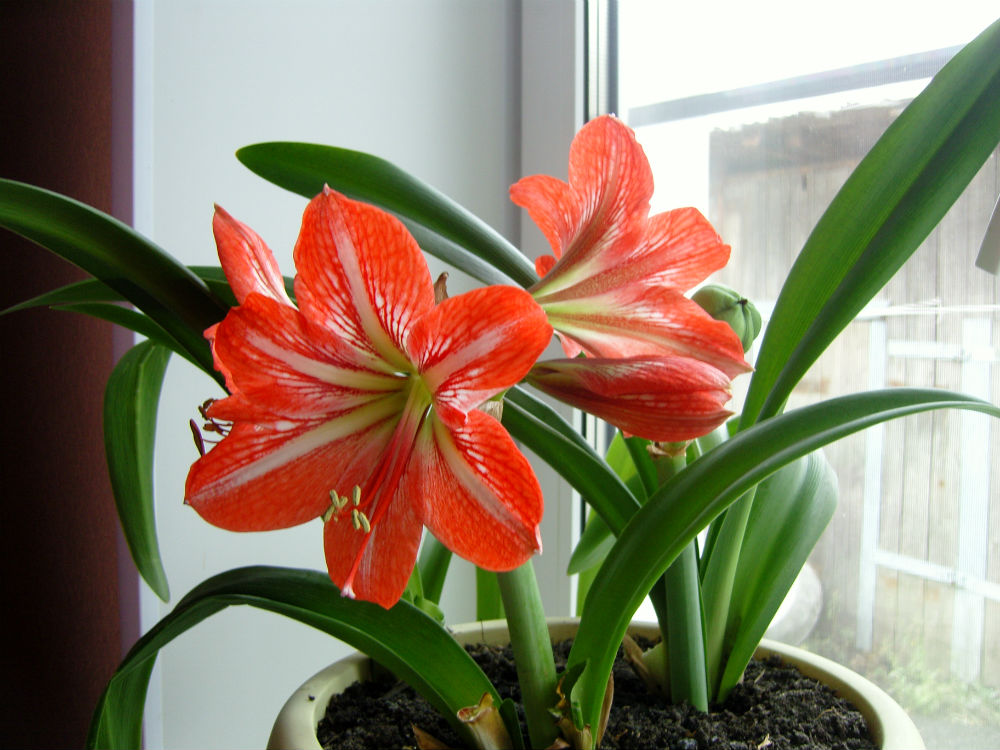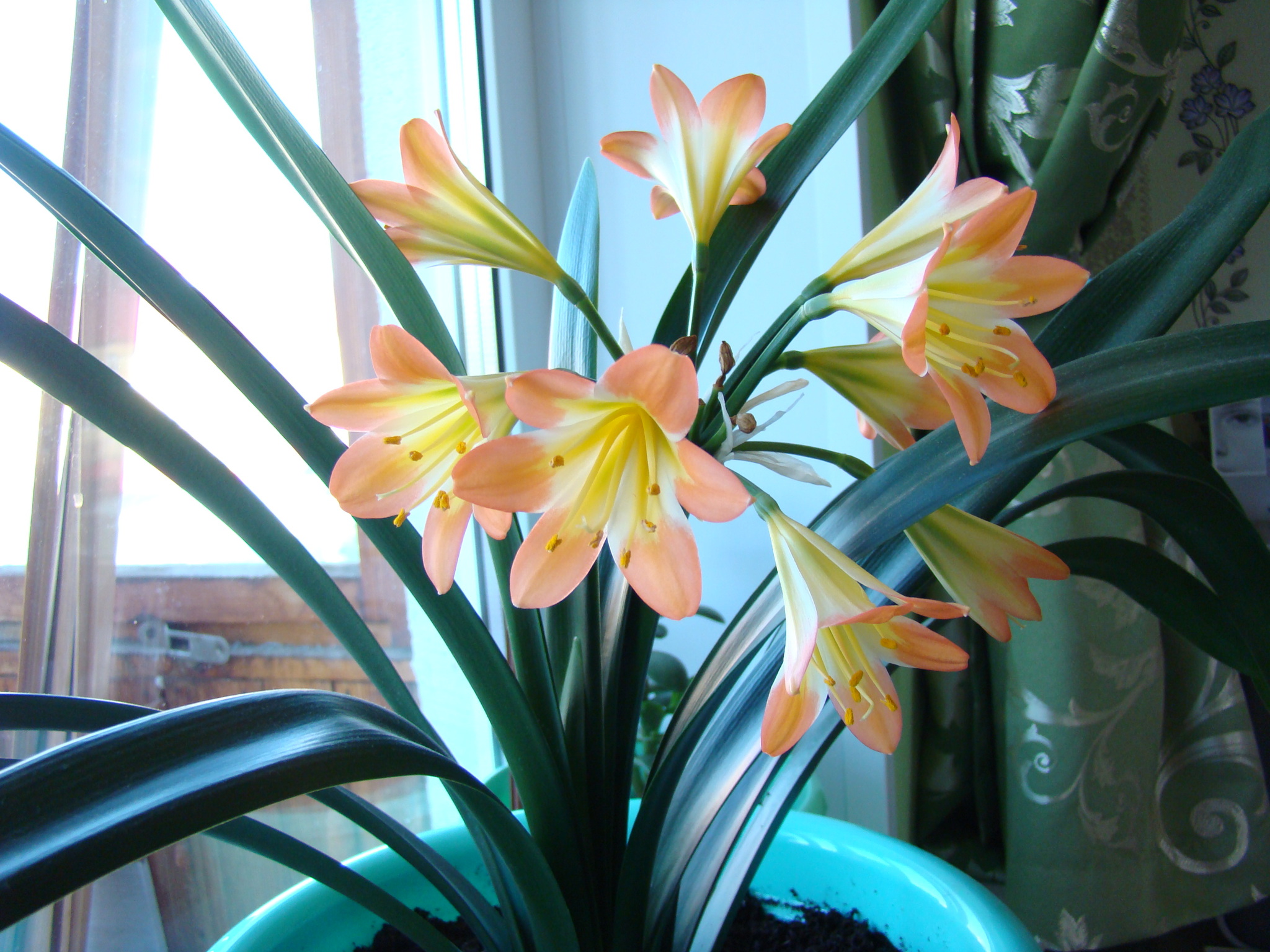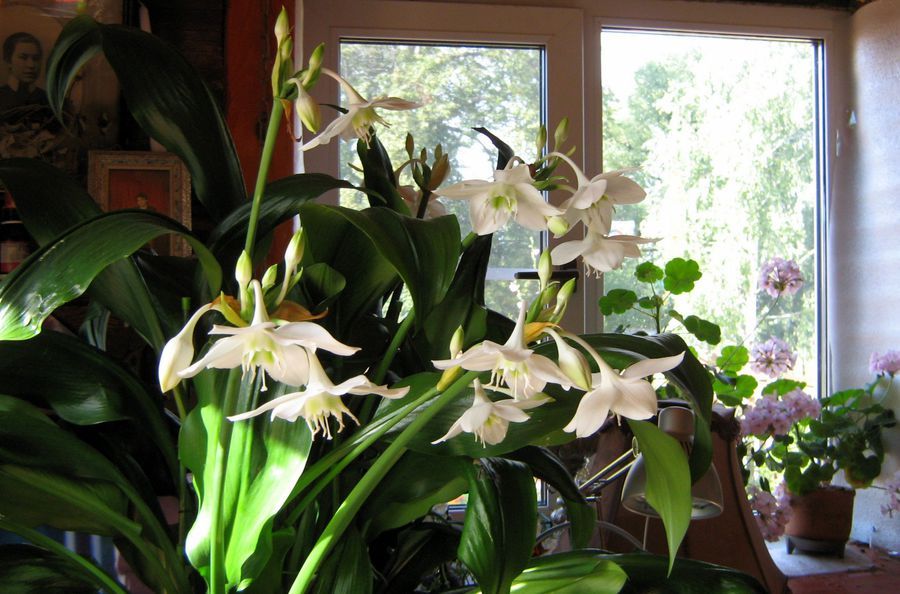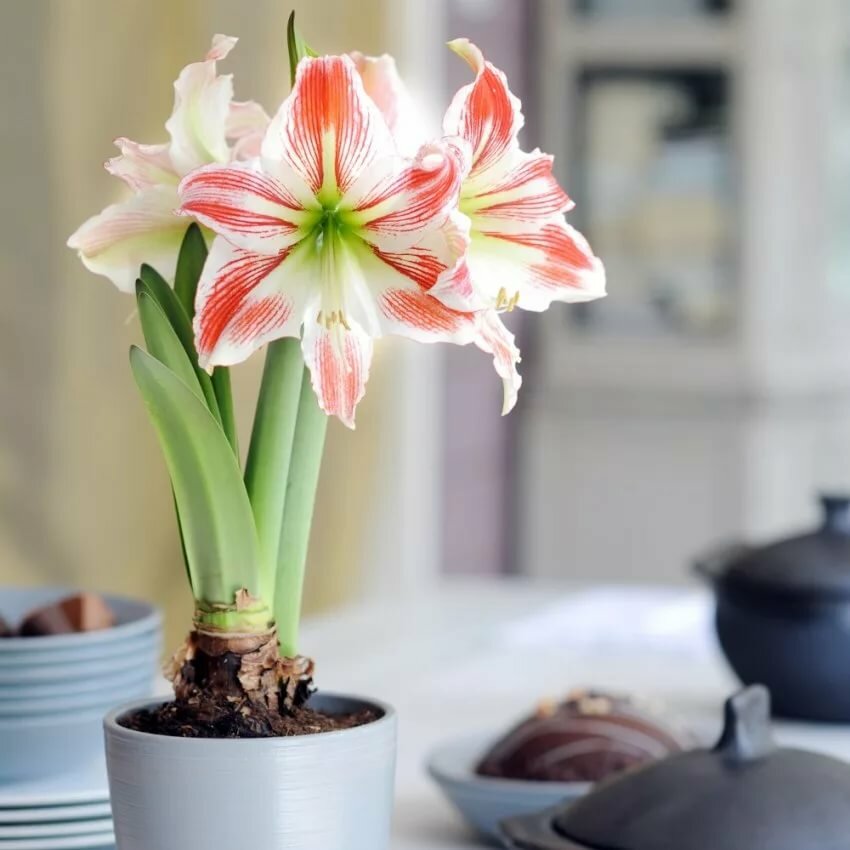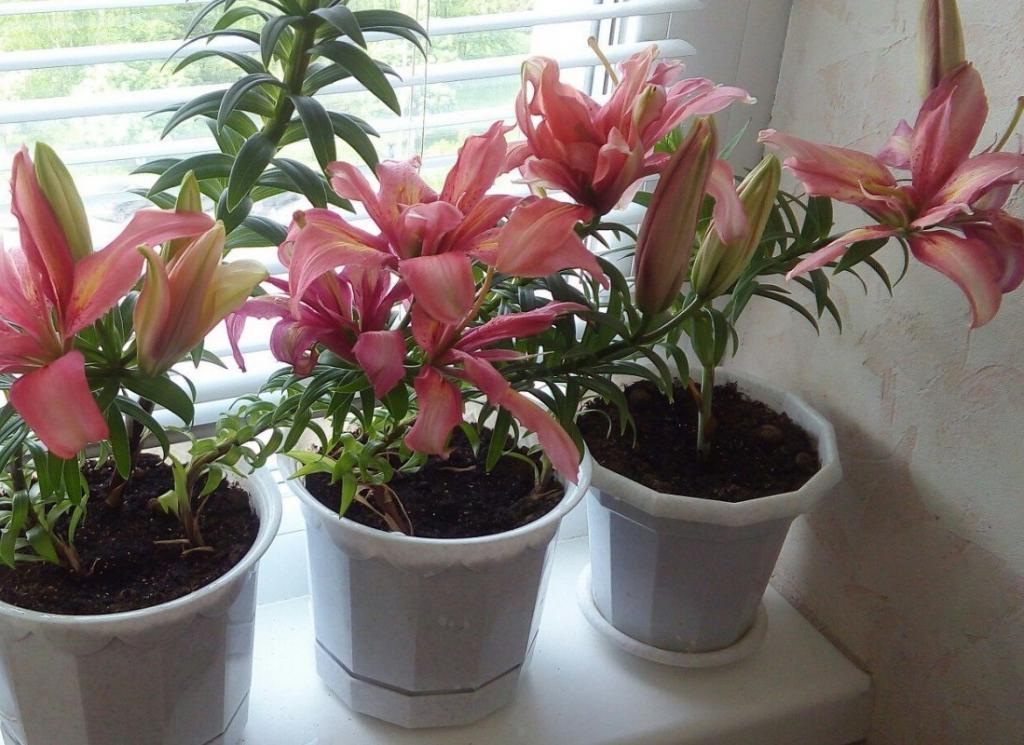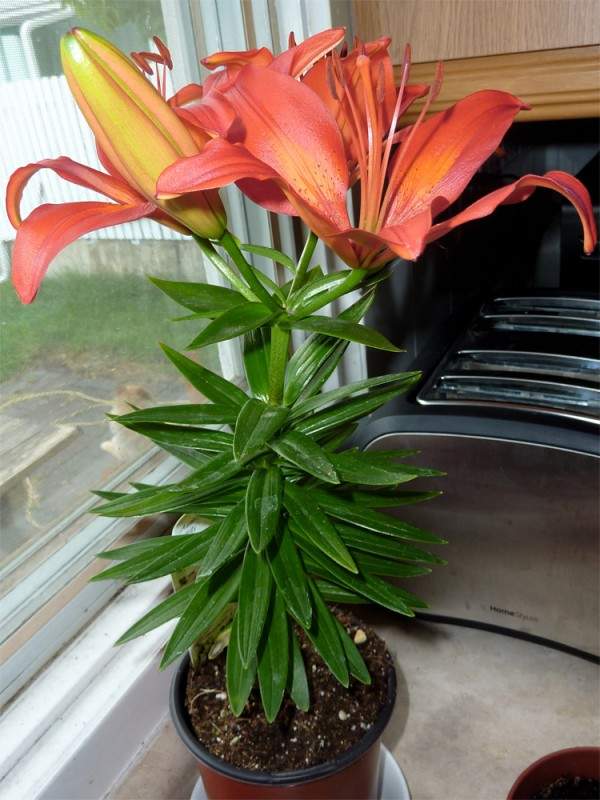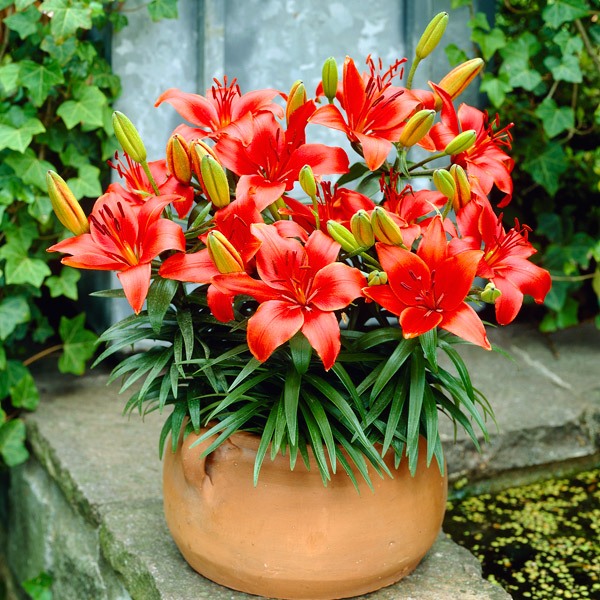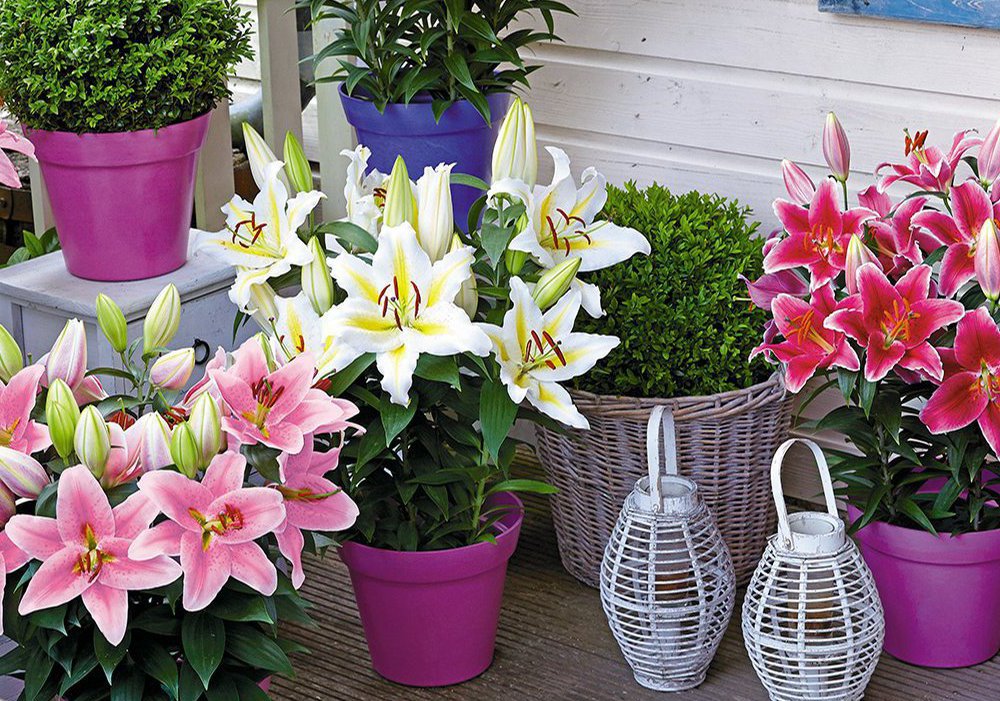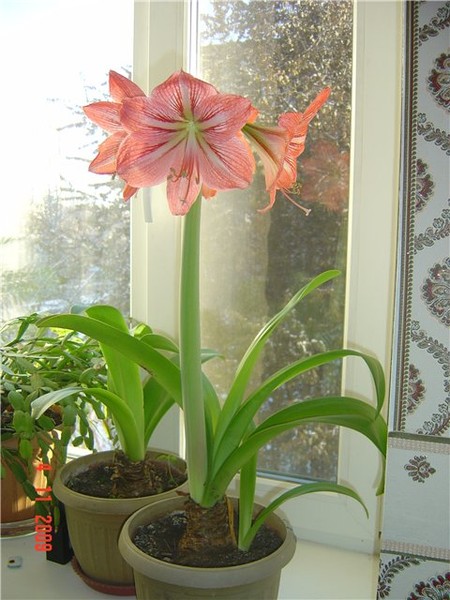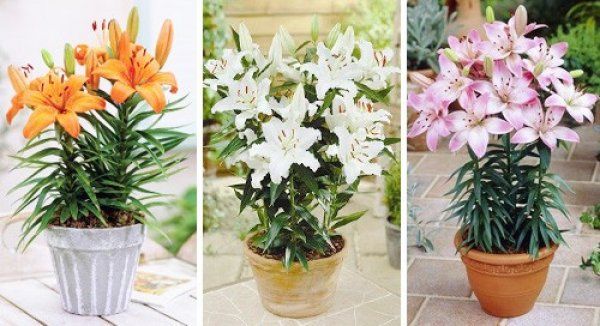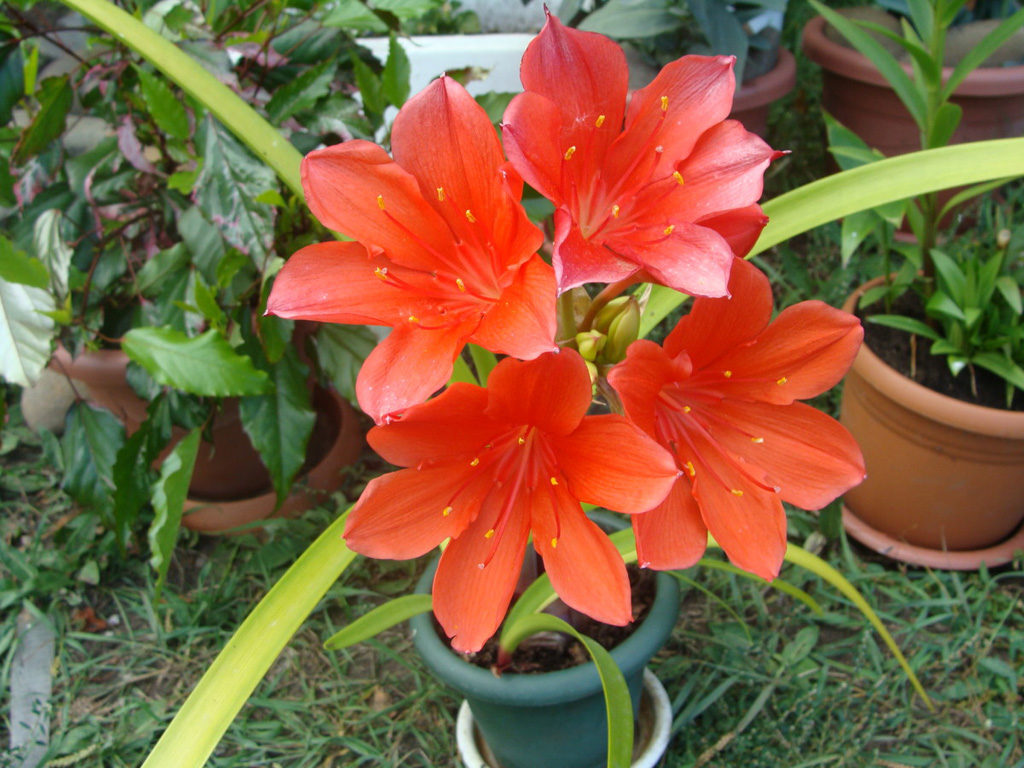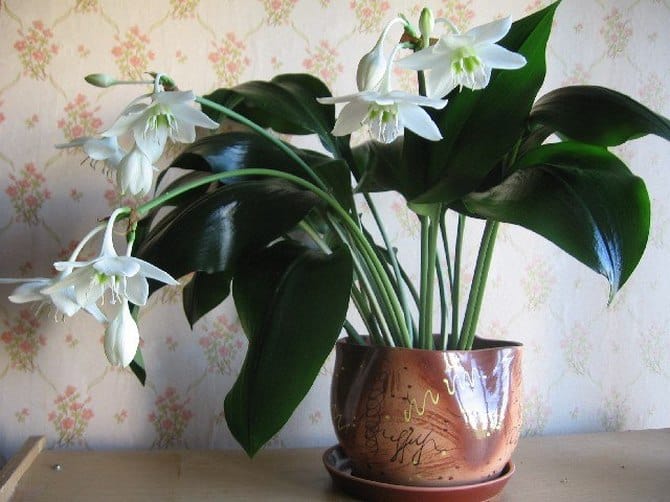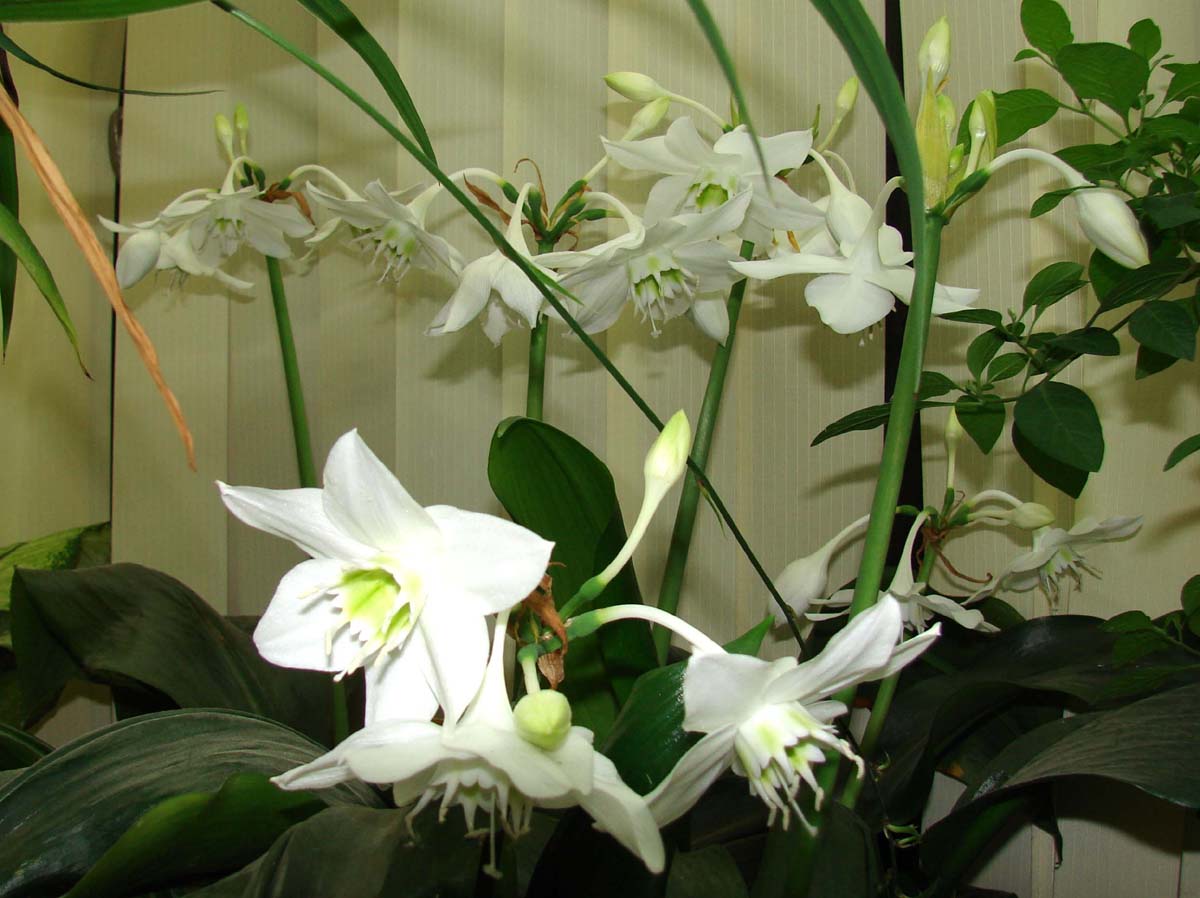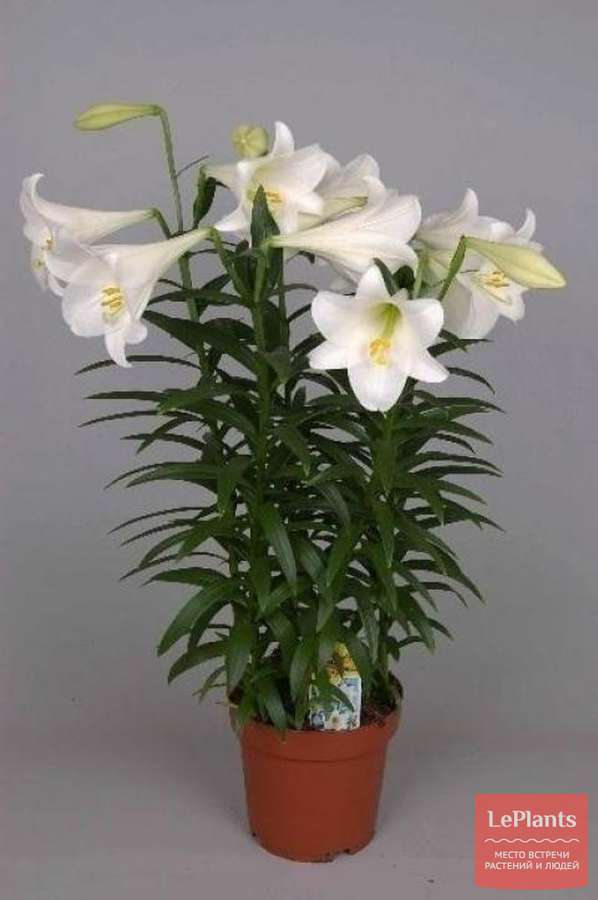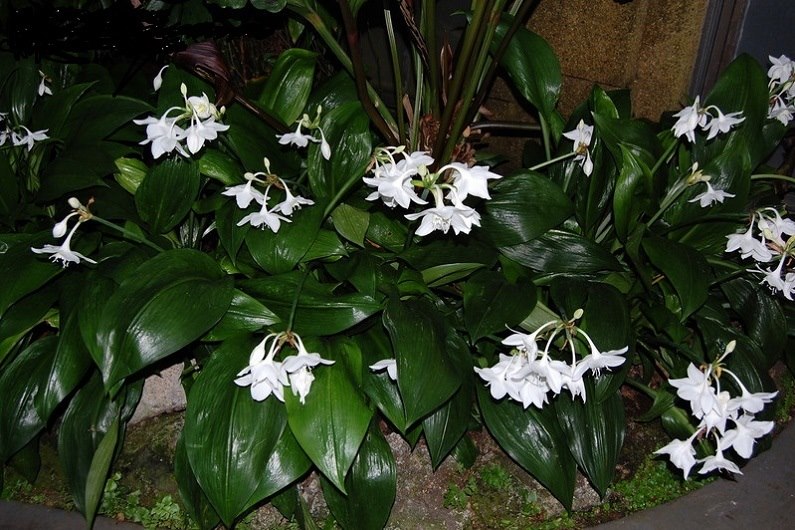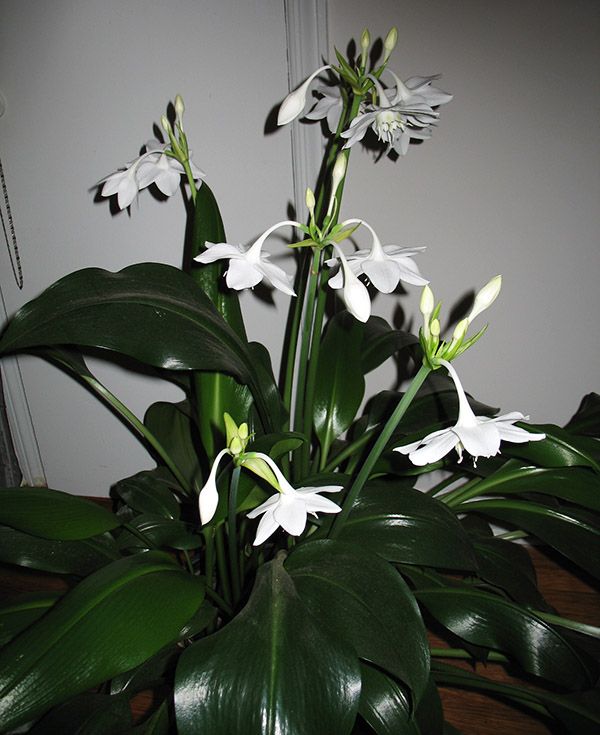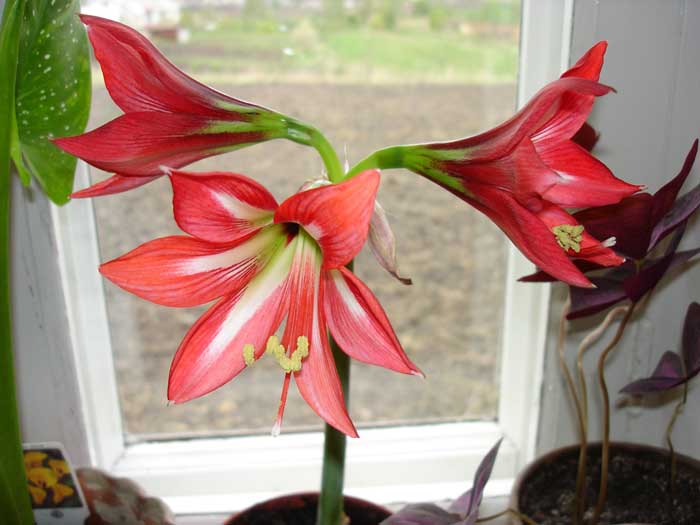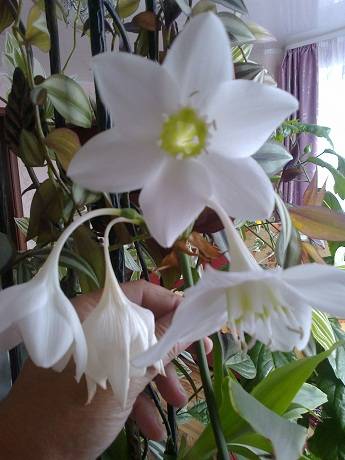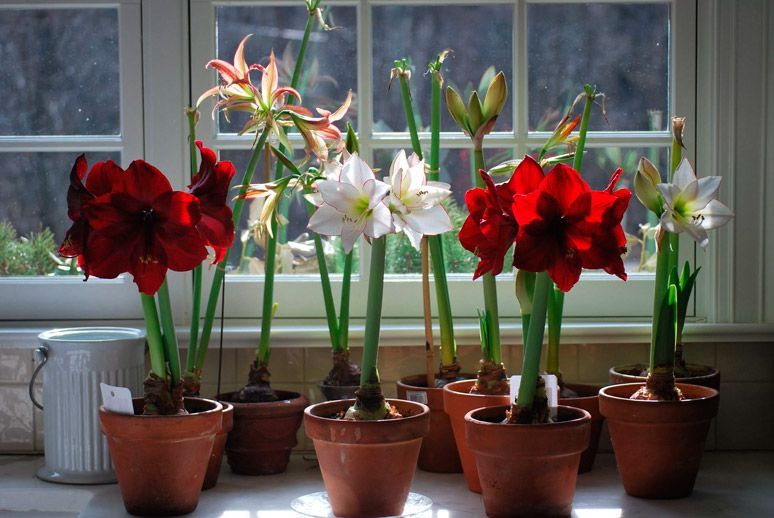Lilies: planting and care
At home, lilies bloom from June to August, and they need to be planted in a pot in early spring. You can create a composition of lilies by planting several bulbs in a container. A 20cm pot is enough for one onion. The earth must be taken light, mixed with sand. Drainage in a lily pot is required, pour a layer of soil on it, place an onion on it, straighten its roots and cover it up to half with earth. The pot should be half full. You can add soil when the stems rise above the container.
Keep the flower in a dark, cool place until shoots appear, but as soon as shoots appear, transfer the lily to the balcony. In the summer, you need to provide the plant with a cool corner where there is an air flow. The soil should be as moist as the air around the plant. Water it regularly until autumn, until the leaves dry up. The soil should be allowed to dry slightly between waterings. Spray the air around the flower. Loosen the soil from time to time and add wood ash to it.
Do not forget to feed the lily with liquid fertilizers: the first time - before the start of growth, the second - during the formation of buds, the third - after flowering until mid-August. After flowering, lilies have a dormant time. In autumn, the dried stems are cut above the bulb itself, the bulbs are dug up and stored in the refrigerator in winter, wrapped in wet moss, or kept in wet sand in the basement. You can transplant the bulb into new soil, add ash there, lightly feed it and water it, then with the onset of spring it will grow faster.
Lily propagates by seeds, but artificial pollination will be required, and this is already an occupation for specialists. In some varieties, spherical formations grow in the leaf axils, which can be planted in the soil and in a year bulbs can be obtained. The easiest way to propagate a lily with children is during autumn digging. Lilies are susceptible to fungal diseases. The reason is waterlogging of the soil or insufficient drainage. If the plant is sick, treat with fungicides.
Cardiocrinum
After this article, they usually read
Add a comment
Planting indoor lilies
It is simple to prepare lilies for planting: garden bulbs need to be kept for 14-20 days at a temperature of 2 to 5 degrees (a refrigerator is perfect) in wet sawdust or peat. As a rule, special varieties and bulbs purchased from nurseries do not require refrigeration. Before planting, soak in a weak solution of potassium permanganate or fungicides in warm water with growth stimulants.
Lilies are planted in a special way, in two stages. After the main planting, the soil will have to be filled up. But there is nothing complicated in this procedure:
- A drainage layer is poured onto the bottom of the container.
- The pot is filled with a layer of soil up to 10 cm high, so that the bulb placed on it is deepened to three of its heights (from 15 to 20 cm from the top of the container).
- The bulb is filled with soil strictly horizontally, top up, leaving a distance of 2-3 cm between the plants and to the walls. There should be 15 to 20 cm to the top of the pot.
- The containers are filled with the substrate, slightly squeezing the bulbs, but trying not to tamp it too much. Half to a third of the bulb should remain above the soil line, and approximately half the pot should be empty. If, when buying potted varieties, it was recommended to fill them completely, follow the instructions, but still leave about 7 cm to the top of the pot to fill in the soil.
- Planting is completed with light watering with warm water.
Types and varieties of room lilies
There are about 300 species of lilies in the world, which are divided into main groups:
- Cup-shaped.Petals of this kind are presented in the form of a bowl - wide open. Cup-shaped varieties include: gilded lily, Empress Lily of China, Grand Commander.
- Funnel-shaped. The petals are tightly packed and form a tube. Funnel-shaped lilies include Long-flowered, Regal, Royal Gold, as well as a dozen hybrids that differ in a variety of colors: from light yellow to bright orange shades. This type is considered the most planted lily - indoor.
- Fezovidnaya. The flower is in the form of bent petals. Fezovidny plants are distinguished by a low stem and a small flower diameter. Lilies such as Dwarf, beautiful species and L. Citronella belong to the fezid lilies.
In addition to the above varieties, there are Asian, American, Oriental lilies, as well as Tubular hybrids, Candidum hybrids, La hybrids, etc.
Each species has its own characteristics that are responsible for resistance to low temperatures and other unpleasant weather conditions.
Common varieties
Tiger, Leopard and Lanceleaf, Water, and Domestic White Lily are considered the most famous varieties. They differ from others in abundant flowering, as well as variegated colors. The tiger lily is found naturally in white, red, pink and yellow flowers.
Chinese lily
The Chinese lily is popularly called the leopard or Belamkanda. Its scientific name is Iris Domestica, as it actually belongs to the iris family. It has a pronounced orange tint with black spots of various shapes. It differs from its relatives in good resistance and abundant flowers.
Asiatic lily
An unpretentious flower that loves bright light and frequent watering. Has a bright color. Needs regular spraying and fertilization of the soil. Asiatic lily is found in light shades.
Briefly about the history of appearance
This royal flower has a rich history and an army of fans. It appeared several centuries ago. It began to be called "lily", because of the translation from ancient Celtic, as "white-white". Associated with purity, lightness and sophistication.
The reason for the yellowness of the leaves of the lily
With its yellow leaves, the plant makes you understand that you are not taking care of it properly. With what it can be connected? There are several important points:
- If autumn has come, then yellow leaves are normal.
- If the pot is on a windowsill in direct sunlight, and when sprayed, droplets of water fall on the leaves, this can cause a burn. In order to avoid such a development of events, the plant must be removed to another place, and the spraying process must be transferred to the evening.
- Excessive dryness in the room. To prevent this from happening, you need to monitor the humidity indicator in the room where the lily is located. If necessary, put a container of water with it in the immediate vicinity. You can place the pot with the plant on a pallet filled with damp pebbles or expanded clay. You can also use a humidifier.
- Lack of nutrition. During the growing season, the flower uses many trace elements, pulling them out of the soil. At this time, he needs a significant amount of iron and potassium. Their lack can lead to yellow leaves due to disruption of the process of photosynthesis. Minerals and a mixture consisting of citric acid (2 tsp) and ferrous sulfate (8 g), diluted in cold water (3 l), must be quickly introduced into the ground.

Is it possible to plant a lily at home
Blooming lily decorates the house not only with the beauty of flowers and bright greenery, but also with a pleasant persistent aroma. More than 300 species of these flowers are known in the wild. Thanks to selection, the lily can be planted and bred at home, in a flowerpot. Lily is not picky about conditions and can grow in one pot for several years.

If you choose the right planting time and provide the most appropriate and timely care for the plant, then you can easily guess with flowering buds for any celebration.
Depending on the variety, the flower can grow up to one and a half meters.
Did you know?
Ancient Greek myths tell: “The severe goddess Hera, finding a little Hercules hidden from her, decided to breastfeed him. The baby, sensing an enemy in her, bit her. The milk that spilled at the same time spilled over into the sky. This is how the Milky Way appeared, and a few drops that fell to the ground became beautiful lilies. "
Choosing lilies for indoor growing
In rooms, you can successfully grow either varieties specially bred for indoor culture or compact varieties that almost do not form children. Some of the lilies that grow well in rooms include:
- special "pot" varieties of royal lily (Lilium regalum);
- beautiful lily varieties (Lilium speciosum);
- long-flowered lily varieties (Lilium longiflorum);
- varieties of golden lily (Lilium auratum);
- potted varieties of the Mid-century group of Oriental and Asian hybrids.
It is worth giving preference to dwarf or undersized (40-60 cm - optimal height) and the most unpretentious, early varieties. The color scheme is chosen according to taste.
For room culture, large (from 40 g), healthy bulbs are used - the best, selected specimens.
Royal lily (Lilium regalum). meolongxu87 Beautiful Lily (Lilium speciosum). Stefano Lily longiflorum (Lilium longiflorum). Nobuhiro suhara
Blooming amazon lily
Two, and sometimes three times a year, eucharis blooms with beautiful flowers, somewhat similar to the flowers of daffodils. The buds open in turn and bloom each up to ten days. Each flower has a narrow, long tube with oval, wide-open petals. Their edges are pointed. The petals are arranged in two tiers. There are 6 of them in total. In the center there is a crown with stamen threads adhered to it. Most varieties of the Amazonian lily have white inflorescences. They say that breeders have bred varieties with blue and cream petals, but we have not yet met such.
 Eucharis is not only distinguished by its external beauty, but also by its ease of care.
Eucharis is not only distinguished by its external beauty, but also by its ease of care.
The diameter of one inflorescence is also different for different species of eucharis. The largest specimens have corollas up to 10-12 cm in diameter. On the peduncle, from 2-3 to 7-10 buds are formed at once. As they dissolve, they fill the surrounding space with a pleasant, delicate scent of lilies. With good care, the first flowering of the year begins in February and lasts an average of a month. The flower re-opens its buds in the fall.
You should be aware that representatives of different species of eucharis can bloom in any month of the year, which is associated with their genetics. After each flowering, there is a short dormant period, and then growth and flowering again. That is, for regular flowering, the plant simply needs a change in periods of active growth and dormancy.
Each corolla in the inflorescence retains its decorative effect on average for about a week, and flowering can continue, depending on the number of buds formed, for about a month.
Note! Young babies bloom only 3-4 years old and only if they are closely kept. Therefore, they are planted at once in several bulbs in one pot. Eucharis is rightfully considered one of the ideal indoor plants.
Eucharis is rightfully considered one of the ideal indoor plants.
A young plant produces only one inflorescence, an older and stronger one can form 2 or 3 peduncles with inflorescences. Note that in different room conditions, different varieties of eucharis behave differently, and you can see a blooming specimen at any time of the year.
Care and feeding
If you follow the recommendations for caring for a white lily, it will bloom very beautifully, fill the house with a magical aroma. There are several general rules that should be used when caring for different varieties of an ornamental plant:
- Watering. All species need regular but moderate watering. Waterlogging of the soil should not be allowed, this can destroy the white lily. Lack of moisture also negatively affects the condition of the flower.
- Top dressing. Throughout the growing season, the plant must be fed with organic fertilizers. A non-concentrated, liquid mullein solution, similar in consistency to ordinary water, is best for this.
- Airing. All species are sensitive to dry and stale air. The room in which the plant is located must be regularly ventilated, but drafts must be avoided.
- Lighting. Indoor lily is a light-loving plant that requires care and maintenance. For normal growth and development, it needs a sufficient supply of solar heat and light.

With proper care, the flower will delight with bright inflorescences
After flowering, all species enter a dormant period. At this time, leaving will be slightly different. The flower needs to be moved to partial shade, watered less often, no need to feed. After the end of this period, mineral fertilizers are applied to the soil. Why is this necessary? To provide the plant with strength for abundant and long-lasting flowering, saturate with useful substances.
Problems when growing eucharis at home
Subject to all the rules of care, eucharis will delight you with its decorative foliage and an abundance of fragrant inflorescences for many years. If gross mistakes are made, then the problems will not take long. Let's take a look at common errors and how to fix them.
The leaves began to turn yellow. If the lower old leaves turn yellow one by one and die off one by one, then this is a natural process. Their time has come. New leaves will grow instead of old ones. If all the leaves, including young ones, have turned yellow, then check:
- What is your room temperature (at 10 grams, eucharis dies).
- quantity and quality of water during irrigation. You cannot completely dry out the soil, but you also cannot arrange a swamp in a pot. Water for irrigation should be soft, filtered, at least settled for a day, at room temperature.
- The place of growing the flower - if the pot stood in the sun for a long time, then the leaves are burnt and fall off.
The eucharis leaves became lethargic. The reasons may vary. Perhaps you forgot to water the flower in time. Do this immediately and the castings are likely to spring back. If you forgot a flower near an open window in winter when airing a room, or did not cover it well during transportation, then the flower is overcooled and the turgor of its leaves may not be restored. Leaves also become lethargic when the roots are damaged. The flower can be saved. To do this, remove the plant from the pot, inspect the bulbs. Remove the rotten ones, cut the damaged ones with a clean knife to healthy tissues, treat the wounds with crushed coal or ash and plant in a new substrate. Drizzle with the addition of fungicide.
The leaves curl up into a tube, deform. Usually, the plant rolls up the leaves in a dry room so that they evaporate less moisture. Wipe the leaves with a damp sponge to remove dust and provide access to water. Spray them daily. Young leaves emerge from the soil rolled into a tube and turn out to be deformed only if they received mechanical damage during unfolding. If all the leaves are deformed, then there may be several reasons:
- hypothermia of the soil and, accordingly, the root system;
- excess fertilizer;
- insect pests.
Falling leaves. If, with the appearance of new leaves, the old ones immediately begin to turn yellow and fall off, then the reason is the lack of resources for the life support of the flower, most often it is a lack of sunlight in the winter. Arrange additional artificial lighting for it, water it regularly and correctly, avoiding waterlogging or drying out of the root system of the flower, feed it with suitable fertilizers.
Eucharis pests
Eucharis is rarely attacked by pests. If you keep him in a comfortable environment, you have nothing to fear from them.If the temperature or watering regime is violated by you, then the parasites will be right there. Consider possible uninvited guests of the Amazonian lily.
Spider mite. This parasite bred on lilies in dry and hot environments. You cannot see them with the naked eye, but you can see how a thin cobweb appears on the leaves, how they become covered with yellow specks, dry out, droop.
If you noticed the signs of these insects in time, then urgently treat the leaves and all ground parts of the plant with a solution of laundry soap. In case of mass defeat, it will be necessary to treat the eucharis with chemical preparations-acaricides, such as mite, phytoverm, acarin and others.
Shield. Dark spots appear on the inside of the leaves - plaques. They can be removed with a damp cloth, and in case of mass defeat, they can be treated with an insecticide.
Sciarids (mushroom gnats). If the soil in the pot is constantly waterlogged, then black midges start in it. Females lay their eggs directly on the roots of the plant. The larvae hatched from the eggs feed on the sap and tissues of the roots of the bulb and oppress it. As a result, the plant weakens, it is no longer able to grow or bloom.
Treat (water) the soil with Aktara solution according to the instructions several times, until the sciarides are completely destroyed. In the future, adjust the frequency of irrigation and the amount of water used for one irrigation. The soil should dry well between waterings by at least a third of the pot. Gently loosen the topsoil to help dry it out.
Amaryllis worm. The pest settles in the scales of the bulb. Leaves and peduncles bend, lose their original shape. The bush dries up and may die. The insect usually gets on a healthy plant from diseased bushes (for example, in a store).
For treatment, use insecticides such as Aktara, Akarin or Vertimek. Both the soil and the entire plant should be sprayed. (Read instructions).
Eucharis rarely gets sick if its owner observes all the rules of care. But if the trouble did occur, do not panic and despair. The methods for treating diseases and controlling insect pests described in this article should help you save your pet.
Eucharis transplant after purchase
Finding eucharis in a store is almost impossible. It can only be bought on forums or local sites, since the plant can only be disturbed during the dormant period that this plant has with leaves, and there is no way to send it as planting material. As a rule, you can buy this lily from your hands right in the pot. Usually a bona fide seller takes care of the soil and no replanting is required. If you still want to plant an onion in your pot, then this should be done like this:
Choose a pot of 12 cm high and the same diameter for one bulb. Necessarily with drainage holes in the bottom.
Fill the bottom with expanded clay with a layer of 3 cm, and then with a layer of soil 5 cm in the form of a mound.
Place an onion on this mound. Spread its roots in different directions along the surface of the slope
Do this carefully, because the roots of eucharis are very delicate and fragile. If you are planting an onion with leaves, then its crown should be 3-6 cm below the top edge of the pot.
Cover the top of the bulb with soil so that only leaves stick out from the ground.
If the onion is small and without leaves, then leave the end of the crown 0.5 cm above the ground.
Gently compact the soil around the onion, water it lightly.
Water sparingly for the first two to three weeks. If it is very hot, then spray the leaves with a fine spray bottle.
 Eucharis will not grow and develop if not transplanted immediately after purchase.
Eucharis will not grow and develop if not transplanted immediately after purchase.
Eucharis usually takes root rather quickly. You will see this on the new leaves that appear 40 days after planting.
On a note! If you nevertheless bought eucharis in a store, then it should be immediately transplanted from a transport pot, in which, for sure, there is nothing but peat, into a new suitable pot with a complete replacement of the soil.
Description
Lily, called Lílium in Latin, is a perennial plant and belongs to the Liliaceae family. The leaves of this bulbous plant can be of a wide variety of shapes - from elongated to oval. The diameter of the bulbs is on average from 2 to 7 or even 20 cm.
Lily flowers can have white, yellow, red, golden, purple, pink, lilac colors of different shades, are distinguished by scalloped or even edges of petals and yellow or black anthers.
Lovers of fantastic flower colors will be pleased with varieties with raspberry, red, yellow spots and stripes on the petals. The diameter of the flower can reach 16-18 cm. 4-5 flowers bloom on each peduncle.
For indoor conditions, compact varietal Lilies are ideal, giving a small number of babies. There are hybrids that grow up to 1.5 m in height, and those that form in the form of a lush bush.
For planting in a pot, it is better to choose oriental, dwarf, long-flowered and Asian varieties, for example, Lily beautiful, golden or hybrids from the Mid Century series.
Diseases and pests
Most often, domestic lilies are subject to fungal diseases. Basically, such problems appear when the owners are too zealous with watering. In the majority of cases, the room lily is affected by gray rot. The presence of such a disease is indicated by mold spots on the leaves and stem of the flower. If gray rot is found, all damaged parts of the plant should be removed. And healthy areas are sprayed with a solution of copper sulfate.
Bulbs can also be affected by a similar fungus - soft rot. This disease affects the tubers as dark, watery spots. At the same time, the bulb becomes soft and moldy. An overly affected specimen cannot be saved. In case of partial damage, it will possibly restore the viability of the culture. To do this, you need to mix coal with sulfur, get the onion out of the ground and process it with this mixture. Then put it in a horny solution for half an hour, stretch it out and let it dry.
Also, a lily houseplant can be subject to such a disease as mosaic. The first signs appear in the form of enlightenment along the veins. In the future, such spots become whitish or yellow. Their number is increasing. And as a result, the entire sheet disappears. It occurs due to damage to chloroplasts and the destruction of chlorophyll. Tissues are affected at the cellular level. Infection occurs as a result of the transfer of a virus from one plant to another. For example, after using the same instruments without disinfection. There are no anti-mosaic drugs. When this disease occurs, the plant is destroyed.
But complex diseases in indoor lilies, photos and names of which are presented in this article, rarely occur. Most often, improper care leads to problems with growing. Therefore, if you notice any aesthetic deviations in the development of the plant, just correct the regime.
A few tips for care:
- If the bulb starts to rot, change the soil and reduce the amount of watering. Also, lack or a small amount of drainage can lead to similar problems.
- If the plant turns yellow, becomes dull, it may lack moisture. In this case, the number of irrigations should be increased.
- At home, lilies are rarely affected by insects. But, if this does happen, treat the plant with a special preparation.
Growing and caring for a room lily is not difficult and interesting. With proper planting and care, the plant will delight with beautiful green leaves and large bright buds.
Rules for caring for lilies in the room
You were presented with a lily in a pot, and you do not know how to care for it - in this article we will consider all the periods of its development.
After planting, the plant needs proper care. The flower is fed with organic matter for the first time after the emergence of sprouts; during the growth period, you can stimulate the lily by spraying "Kornevin" twice a week.
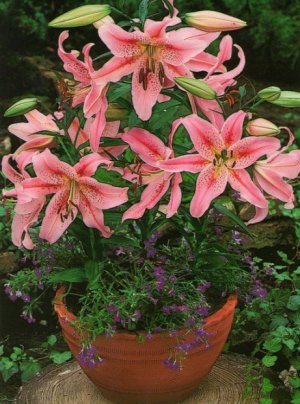
A week after the first fertilization, carry out the second procedure with the composition of the potassium-phosphorus solution. When the shoots reach 10 cm, add soil to the pot to the top. Moderate watering should be done every day.
A one-month-old plant can be exposed to fresh air, gradually increasing the "walk" time from 30 minutes to 10 hours. Do not allow the plant to stay at temperatures below 10 ° C. Until the flowers are in full bloom, spray the lily leaves every day.
Plant care during active flowering
To properly care for a plant, you need to know how to water a lily in a pot at different periods of its life. During the ripening of the buds, the penultimate feeding is done.
To ensure a beautiful flowering, you need to loosen the top of the soil more often, ensuring oxygen saturation of the root system. The flowering plant is watered every 2 weeks, the leaves can be sprayed more often.
If the lily has produced a lot of heavy buds, tie the stem to a support so it doesn't break under the weight of the flowers. It will be useful to spice up the soil with wood ash, this will add comfort and splendor to the plant.
How to care for a lily after flowering
After the lily has faded and all the petals have fallen off, you need to wait for the stems to dry and turn yellow. During this period, water once a week, with obligatory fertilizing with mineral fertilizers and organic matter.

It is no longer necessary to spray the foliage, because during this period all the nutrients from the stems pass into the bulbs and form buds for reproduction in the next planting season.
When the branches of the plant are completely dry, watering stops. Now you need to figure out how to cut a room lily.
Dried inflorescences are carefully cut off, and seed pods are also removed so that the flower is completely rested.
Attention! It is extremely undesirable to cut branches - from them, even dry ones, accumulated nutrients go to the onions
Watering, temperature and feeding
Lilies love fresh air, so it is recommended to ventilate the room with the flower.
Proper watering and temperature control are the main conditions for growing a healthy plant. Indoor lilies perfectly tolerate temperature fluctuations
But it is important not to allow the temperature in the room to change to below 16 ° С and above 30 ° С
The home lily just loves fresh air. For this reason, it is useful to take out indoor lilies on a balcony or loggia in the warm season. And best of all - to the courtyard, if it is a private house. But if there are no such opportunities, it is recommended to open windows and vents more often. Just put the plant further away so that it does not catch a cold from the draft.
Lily responds well to bright, diffused light. But it is impossible to keep the plant in direct sun, as this can lead to leaf burns. This is especially true of the southern windows, where it is always very hot and a lot of sun. But even full shade will not do anything good for the growth and flowering of lilies.
In hot summer, lilies in pots are very fond of moisture. Therefore, they need to be watered often - at least once every 3 days.
It is very important not to allow the earthen feed to dry out completely. From this, the onion can begin to deteriorate.
In winter, it is necessary to water the plant more moderately. It is best to test the potting soil before pouring in the next batch of water.
And the plant should be fertilized already in the first days after the germination of the bulb. It is recommended to start with preparations with a high content of organic substances. After two weeks, feed the lily with potassium-phosphorus fertilizer.
As soon as the lily blooms, you will need to apply special liquid fertilizers for flowering indoor plants every two weeks. In this case, it is also recommended to do foliar dressing by spraying the still unblown buds with a nutrient diluted in the required proportions from a spray bottle.
So, when growing a room lily, which is easy to take care of at home, if you follow the recommendations described above, it is very important to cut the first buds. This will further contribute to the formation of a strong plant, which will surely please with numerous beautiful flowers already next year.
But this only applies to young lilies. In all other cases, during the flowering period, you just need to provide the plant with peace so that it does not drop the buds, try not to transfer it to other places in the apartment or house.
Diseases and pests
Pests rarely infect indoor plants. But excessively dry air contributes to their appearance. Lilies can infect: spider mites, aphids, mealybugs. In this case, you can see insects on the foliage or stem, and also learn about their appearance by the following signs:
- yellowing, falling leaves;
- lethargy, growth retardation.
It is necessary to purchase means for the destruction of uninvited guests in a specialized store and use them according to the instructions.
Indoor lily care, as already mentioned, involves an uncomplicated
In order to recognize a plant disease in time, you should pay attention to the following phenomena
- The yellowing of the leaves is due to the dry air. It is necessary to pour expanded clay into the pallet and keep it constantly moistened, spray the foliage, use a humidifier.
- Leaves turn yellow in spots or on one side from sunburn. It is necessary to rearrange the pot in the shade.
- Due to the lack of mineral and organic substances, the foliage withers and turns yellow. Feeding is carried out 1-2 times a week.
- Leaves fall off, become sparse, thinned due to lack of light or lack of essential organic matter.
- Gray and red rot affects the plant due to abundant watering and stagnant moisture.
- Fusarium affects the root system, the leaves turn yellow, fall off, the bulb gradually collapses. To prevent the disease, the bulbs are kept for half an hour in a solution of foundationol before planting.
- The fungus develops when the air is too warm and humid. Yellow spots are formed on the leaves and stem. The plant most often dies.
Growing lilies in pots without transplanting is permissible for 2-3 years. In order for the plant to delight in lush color next spring, it must winter in a cool, dark place. Water enough once a month.

